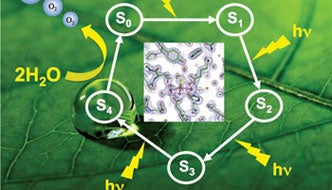With support from the Photosynthetic Systems Division at the U.S. Department of Energy (DOE), researchers in the School of Science are expanding a successful research program to uncover the minute workings of the photosynthetic protein, Photosystem II. The high-impact research, led by K.V. Lakshmi, seeks to adapt photosynthesis for artificial use as an abundant source of renewable energy.
“I think of Photosystem II as the ‘engine of life,’” said Lakshmi, associate professor of chemistry and chemical biology, and scientific lead at the Baruch ’60 Center for Biochemical Solar Energy Research. “Photosystem II powers the planet with solar energy. If there is a design that is perfect for harnessing the energy of the sun, this is it. And we want to use nature as a blueprint to design a new generation of bio-inspired solar cells that builds on the efficient design principles of nature.”

Powered by light, the photosynthetic protein Photosystem II breaks apart molecules of water in five distinct steps known as “S-states.”
Photosystem II, found in plants and cyanobacteria, uses photons of light to break apart molecules of water, extracting electrons to fuel the photosynthetic conversion of light and water into chemical energy for cellular functions. This reaction—solar oxidation of water—takes place in a cluster of oxygen, manganese, and calcium ions called the “oxygen-evolving complex.” The oxygen-evolving complex uses four photons of light to split two molecules of water in five distinct steps known as “S-states.” Each intermediate S-state, numbered from S-0 to S-4, is measured in trillionths of a second, and the final three S-states are highly unstable, making it difficult to determine the exact mechanism by which they occur. In research published in 2012, and supported by the DOE, Lakshmi and her team used advanced spectroscopic techniques to describe the exact atomic-level mechanism of S-2, the third step in the process.
The new $500,000, three-year DOE grant expands the scope of Lakshmi’s research to the structure of the oxygen-evolving complex through the remaining five S-states. In addition, the Baruch ’60 Center is designing an artificial oxygen-evolving complex with the goal of developing man-made photosynthetic devices that capture the efficiency of the light reactions of photosynthesis.
The DOE grant also supports a partnership with Shengbai Zhang, the Gail and Jeffrey L. Kodosky ’70 Senior Constellation Professor in Physics, Information Technology, and Entrepreneurship, to develop computational models that augment the leading-edge experimental techniques that Lakshmi developed in her 2011 research at the Baruch ’60 Center. The quantum mechanical calculations that address this highly complex scientific problem are made possible by leveraging the petascale supercomputing system—the most powerful university-based supercomputer in the Northeast and the most powerful supercomputer at a private university in the United States—recently installed at the Rensselaer Center for Computational Innovations.
In describing the mechanism of the S-2 intermediate state, Lakshmi developed techniques that allowed her to isolate the protein from cyanobacteria and spinach, and then use liquid helium to cool the protein and slow its movements. At the precise moment at which the oxygen-evolving complex is in the S-2 intermediate state, she takes real-time snapshots of the transformation using pulsed electron paramagnetic resonance spectroscopy.


